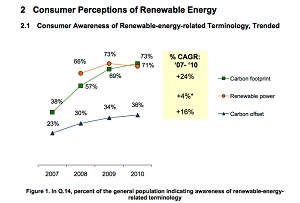Report: Consumers less likely to buy renewable energy than before
 The National Renewable Energy Laboratory (NREL) held a webinar on July 20 discussing what consumers in the U.S. think about renewable energy like wind and solar.
The National Renewable Energy Laboratory (NREL) held a webinar on July 20 discussing what consumers in the U.S. think about renewable energy like wind and solar.
Although the number or respondents who care about renewable energy is high, at 80 percent in 2010, the overall number has fallen slightly from previous years.
“This unfortunately has declined over time. This is consistent with broad environmental attitudes that we track,” said Gwynne Rogers of the Natural Marketing Institute (NMI). “About 7 percent of U.S. adults report buying at least some renewable energy for their homes. We think there is still a lot of opportunity for growth in the renewable energy market.”.
Rogers authored the report: Consumer Attitudes About Renewable Energy: Trends and Regional Differences. The data was extracted from NMI’s Lifestyles of Health and Sustainability (LOHAS) Consumer Trends Database, which has been collecting data since 2002.
For 2010, it surveyed 4,000 general population residents throughout the country for the report, she said.
But the news isn’t necessarily all bad for renewable energy, according to Rogers.
“These data indicate something else going on,” she said. “When consumers see a lot of attention being paid to an issue, their—at least—subconscious reaction is that the problem has been solved. And if all of these major companies, Nissan, Clorox, Wal-Mart, are making significant investments in green products, they think that must mean that I don't need to worry about protecting the environment—other people are taking care of that. When we make something easier for consumers, there is less alarm.”
The recession also likely had an impact on people’s knowledge of renewable energy, Rogers said.
“Things definitely changed after 2008,” she said.
That year, the survey was conducted just before the markets’ crashing became widely public.
“The recession took its toll on price sensitivity. There’s an increase in the number of consumers that say they care about the environment, but that their purchase is determined by price,” she said. That's at 70 percent of respondents.
There’s also an interesting correlation with the nomenclature of sustainability. For instance, the terms renewables has been around for a long time, and in the number of people who are aware of it rose from 66 percent in 2006 to 73 percent in 2009, falling slightly to 71 percent in 2010.
On the other hand “Carbon Footprint” a relatively new term that came about close to the time An Inconvenient Truth came out, gained quicker traction.
“It may resonate with people more than renewables,” Rogers said.
Regionally, more people in the Western U.S. cared about renewables. But the concern for more renewables was higher in the Northeastern U.S., Rogers said.
The survey did not distinguish between different types of renewable energy, like wind and solar, according to Rogers. The 2011 survey will be conducted shortly, but it’s not likely to distinguish this year either, Rogers said.
“Hopefully, in a few months, I'll be able to report that we've bounced back to where we were in 2008,” she said



